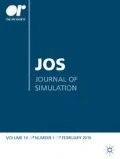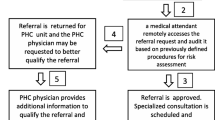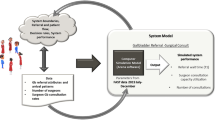Abstract
Most telemedicine studies are concerned with either the technological or diagnostic comparisons, rather than assessing the impact on clinic management. This has attributed to the retrospective nature of the studies, with lack of data being the main cause for not using simulation for prospective analysis. This article demonstrates the use of simulation to assess the impact of prospective systems by utilising data generated from clinical trials. The example used here is the introduction of remote consultations into an outpatient's clinic. The article addresses the issues of using secondary data, in terms of the differences between the trial, the model and future reality. The result of running the simulation model show that exchanging the mode of service delivery does not improve patient wait times as expected, and that a protocol change in association with the introduction of remote visits is necessary to provide a substantial reduction in patient wait times.






Similar content being viewed by others
References
Aoki N, Dunn K, Johnson-Throop KA and Turley JP (2003). Outcomes and methods in telemedicine evaluation. Telemed J E Health 9: 393–401.
Coughlan J, Eatock J and Eldabi T (2006). Evaluating telemedicine: A focus on patient pathways. Int J Technol Assess Health Care 22: 136–142.
Dangerfield BC and Roberts CA (1996). Relating a transmission model of AIDS spread to data: Some international comparisons. In: Isham V and Medley G (eds). Models for Infectious Human Diseases: Their Structure and Relation to Data. Cambridge University Press: Cambridge, UK. pp 473–476.
Dangerfield BC and Roberts CA (1999). Optimisation as a statistical estimation tool: An example in estimating the AIDS treatment-free incubation period distribution. Syst Dyn Rev 15: 273–291.
Eedy DJ and Wootton R (2001). Teledermatology: A review. Br J Dermatol 144: 696–707.
Eldabi T, Paul RJ and Taylor SJE (2000). Simulating economic factors in adjuvant breast cancer treatment. J Opl Res Soc 51: 465–475.
Eldabi T, Paul RJ and Young T (2006). Simulation modelling in healthcare: Reviewing legacies and investigating futures. J Opl Res Soc 58: 262–270.
Fone D et al (2003). Systematic review of the use and value of computer simulation modelling in population health and health care delivery. J Public Health Medi 25: 325–335.
Jun JB, Jacobson SH and Swisher JR (1999). Application of discrete-event simulation in health care clinics: A survey. J Opl Res Soc 50: 109–123.
Lagergren M (1998). What is the role and contribution of models to management and research in the health services? A view from Europe. Eur J Opl Res 105: 257–266.
Law AM and Kelton DM (2000). Simul Model Anal, 3rd edn. McGraw-Hill: New York.
Lewin Group Inc. T (2000). Assessment of approaches to evaluating telemedicine: Final report. Department of Health and Human Services.
May C, Finch T, Mair F and Mort M (2005). Towards a wireless patient: Chronic illness, scarce care and technological innovation in the United Kingdom. Soc Sci Med 61: 1485–1494.
MGH Hospital (2009). http://www.massgeneral.org/about/overview.aspx, Accessed 23 February 2009.
Roine R, Ohinmaa A and Hailey D (2001). Assessing telemedicine: A systematic review of the literature. Can Med Assoc J 165: 765–771.
Sanchez SM et al (2000). Emerging issues in healthcare simulation. In: Winter Simulation Conference Proceedings IEEE Computer Society, pp 1999–2003.
Savin S (2006). Managing patient appointments in primary care. In: Hall RW (ed). Patient Flow: Reducing Delay in Healthcare Delivery. Springer: New York, pp 123–150.
Standridge CR (1999). Tutorial on simulation in health care: Applications and issues. In: Winter Simulation Conference Proceedings IEEE Computer Society, pp 49–55.
Tunnicliffe Wilson JC (1981). Implementation of computer simulation projects in health care. J Opl Res Soc 32: 825–832.
Author information
Authors and Affiliations
Corresponding author
Rights and permissions
About this article
Cite this article
Eatock, J., Eldabi, T. Incorporating remote visits into an outpatient clinic. J Simulation 3, 179–188 (2009). https://doi.org/10.1057/jos.2009.11
Received:
Accepted:
Published:
Issue Date:
DOI: https://doi.org/10.1057/jos.2009.11




